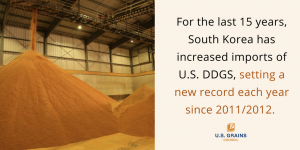A long tradition of partnership and dedicated interaction by organizations like the U.S. Grains Council (USGC) has established South Korea as one of the largest and most loyal trading partners for the United States.
The United States and South Korea will begin to formally examine the U.S.-Korea Free Trade Agreement (KORUS) during talks in Washington, D.C., on Jan. 5. Emphasizing the benefits of KORUS to further solidifying and expanding exports is an important part of that discussion.
“Korean consumers and traders recognize the United States as a leading origin for imported agricultural goods of good quality and value,” stated a November 2017 Global Agricultural Information Network (GAIN) report by the U.S. Department of Agriculture’s (USDA’s) Foreign Agricultural Service (FAS). “[KORUS], implemented in March 2012, coupled with ongoing recovery of the Korean economy should generate greater export opportunities for American products in Korea in the coming years.”
The KORUS agreement offered key market access provisions for U.S. feed grains and co-products, including immediate duty-free access for U.S. corn and sorghum exports. The agreement also includes a 2,500 ton (nearly 115,000 bushels) duty-free quota for U.S. barley, which increases 2 percent each year while full tariffs are phased out, as well as important provisions offering increasing market access for beef, pork and poultry products.
As a result, U.S. exports of feed grains in all forms to South Korea have steadily increased, reaching 8.32 million metric tons in 2016/2017, a 57 percent increase year-over-year. The 2016/2017 sales numbers include a six year-high for U.S. corn at 5.6 million tons (220 million bushels), placing South Korea as the third largest world buyer.
In addition, 96 percent of feed millers in South Korea now include U.S. distiller’s dried grains with solubles (DDGS) in their rations for the country’s livestock and poultry industries, thanks in part to work started by the Council in 2004 to introduce this feed ingredient. As the third largest buyer of U.S. DDGS in 2016/2017 at 980,000 tons, South Korea set a new record for imports, which the country has done every year since 2010/2011. Now the Council is working to increase inclusion rates for U.S. DDGS, which would provide additional opportunities for increased exports.
“South Korea is already U.S. agriculture’s fifth largest export market,” stated another FAS GAIN report, issued in December of last year. “Still, the unique market dynamics between South Korean consumption and economic expansion, U.S. production cycles, and the history of our bilateral relationship, demonstrate the special value of the [Republic of Korea] market for American agriculture.”
“Given the increasing number of Korea’s FTAs with other trading partners, even marginal real or future assumed tariff advantages can have an important impact on Korean buyers, especially those processing inputs into finished products for local consumption.”
South Korea has existing free trade agreements with 52 countries. The Korean government is also actively looking at trade agreements with both MERCOSUR (South America’s trading bloc) and Russia, meaning the United States needs the market access provided by KORUS in order to remain competitive in this market.
The Council celebrated 45 years of working in South Korea in 2017 during a joint officers mission with the National Corn Growers Association (NCGA) in November 2017. During the mission, leaders from both organizations recognized how the KORUS agreement shifted decades of market development into record exports to the East Asian nation.
“Our customers told us they have options too,” said Deb Keller, USGC chairman from Iowa, in an audio interview about the joint officers mission. “The Council will maintain a strong presence in the South Korean market and work to keep communication lines open across feed, food and energy sectors.”
Learn more about the Council’s work in South Korea here.


